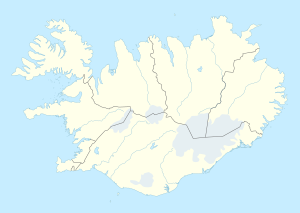Vaðlaheiðargöng
| Vaðlaheiðargöng | ||
|---|---|---|
| use | Road traffic | |
| traffic connection |
Hringvegur |
|
| place | Akureyri | |
| length | 7206 m | |
| vehicles per day | 1825 | |
| Number of tubes | 1 | |
| construction | ||
| start of building | 2013 | |
| completion | 2018 | |
| business | ||
| toll | 1500 IKr | |
| release | January 12, 2019 | |
| Vaðlaheiðargöng | ||
 between the Eyjafjörður and the Fnjóskadalur
|
||
| location | ||
|
|
||
| Coordinates | ||
| Eyjafjörður → Akureyri portal | 65 ° 41 ′ 37 ″ N , 18 ° 3 ′ 13 ″ W. | |
| Portal Fnjóskadalur | 65 ° 43 ′ 43 " N , 17 ° 55 ′ 5" W. | |
The Vaðlaheiðargöng are a road tunnel in northern Iceland . The ring road has been running through it since the end of 2018 , which has shortened the distance between Akureyri and Húsavík by 16 km.
history
The earliest connection from Akureyri to the east was over the Bíldsárskarð pass. It is about 10 km south of the tunnel and had a pass height of 642 m. Around 1930 the road already led over the Vaðlaheiði over the 520 m high Steinskarð pass. This path with its 13 switchbacks was difficult to drive. Since 1985 the ring road ran over the Víkurskarð (325 m) and was not always passable in winter.
technology
The tunnel leads 7,206 m through the mountain, plus 84 m protective tunnel in the west and 224 m in the east. In Eyjafjörður the road is at an altitude of 60 m above sea level and rises 1.5% to 230 m. From there it has a gradient of 2%. In Fnjóskadalur it ends at a height of 160 m.
The tunnel is through tolls are first refinanced to 25 years. At the time of opening, 1,200 vehicles are expected to pass through the tunnel every day.
Construction progress
Construction work began on April 2, 2013 and the first demolition took place on July 3, 2013. In the 3rd week of 2017, 5036 m from the west and 1656.5 m from the east had been dug, a total of 6692.5 m or 92.8% of the tunnel. The tunnel was originally supposed to be completed by the end of 2016. After delays, the breakthrough in February 2017 and the opening of the tunnel in summer 2018 were expected as of January 2017; however, the breakthrough was further delayed and should now be achieved by the end of April 2017.
The delays in the construction of the tunnel resulted from hot water ingress , among other things . A competition is to be announced for the use of geothermal energy .
The last blast in the tunnel was carried out on April 28, 2017 at 3:30 p.m. Asphalting work began in the tunnel in the 27th week of 2018. Commissioning of the tunnel was planned for the beginning of December 2018. It was released on December 21, 2018 for free passage until the turn of the year. From January 2, 2019, the toll had to be paid. The Vaðlaheiðargöng were officially inaugurated on January 12, 2019. There are no cash registers at the tunnel, instead the toll has to be paid online. For a car that is 1500 Icelandic kronor if you pay within 3 hours. If you pay later, you have to pay 2500 Icelandic kronor.
See also
Web links
- Construction progress on the tunnel (Icelandic)
- Mautbesahlsystem (English)
Individual evidence
- ↑ Jarðgöng á vegakerfinu. Retrieved January 13, 2020 (Icelandic).
- ↑ http://www.vadlaheidi.is/static/files/j201.pdf
- ↑ a b Framvinda verks. Vaðlaheiðargöng hf., Accessed April 8, 2017 (Icelandic).
- ↑ Rögnvaldur Már Helgason: Gegnumslag í Vaðlaheiði gæti orðið í febrúar. In: ruv.is. Ríkisútvarpið , January 12, 2017, accessed January 29, 2017 (Icelandic).
- ↑ Rögnvaldur Már Helgason: Efna til Keppni to nýtingu hitans í Vaðlaheiði. In: ruv.is. Ríkisútvarpið, March 6, 2017, accessed April 8, 2017 (Icelandic).
- ↑ 17 vika 2017 vika 185 í gangagreftri; lengd ganga altogether 7,206m. Retrieved May 2, 2017 (Icelandic).
- ↑ Malbikun hafin í Vaðlaheiðargöngum. Retrieved July 11, 2018 (Icelandic).
- ↑ Vaðlaheiðargöng opnuð fyrir umferð. Retrieved December 23, 2018 (Icelandic).
- ↑ Welcome to Vaðlaheiði tunnel. Retrieved March 4, 2019 .
